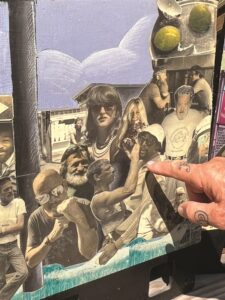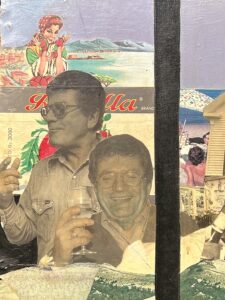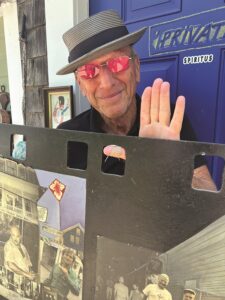Over nearly two weeks in August 1982, Arnie Charnick and his then-girlfriend Cherie Nutting walked around Provincetown photographing the town and its inhabitants.

“We didn’t make a list or anything,” says Charnick. “We just took pictures of whoever I knew that we happened to run into.” Starting out in the far East End, the two made their way toward Herring Cove, eventually ending at the airport.
Nutting developed the film in her darkroom, and Charnick edited, trimmed, and hand-tinted hundreds of photos before collaging them onto 20 Masonite panels with painted background elements and fragments of postcards and other ephemera. Then he added sprocket-shaped cutouts to the edges of the panels to give the appearance of a giant filmstrip. The assembled panels are 44 feet long.
“We were just boppin’ around town taking pictures,” says Charnick. “So, I called it Boppin’.”
A kaleidoscopic portrait of life in Provincetown four decades ago, Boppin’ is also a tribute to “the gone but not forgotten and the still alive,” Charnick says. The piece will be on display at Spiritus (190 Commercial St., Provincetown) for two weeks beginning Thursday, July 27, with an opening reception on Friday, July 28 at 6 p.m.

The installation at Spiritus will be the first time the piece has been exhibited since 2007 and only the fourth time it has been shown publicly since its unveiling 41 years ago. Charnick says Boppin’ was purchased after its first showing by a Provincetown business owner who later lost it to “someone from a prominent local family” in an all-night pool game, though he declines to name the parties involved more specifically. “I’m redacting the names to protect the innocent and the guilty,” he says.
Charnick and the current owner of the mural, a Provincetown native who asked that he not be named, are looking to sell it for $20,000 — “a fair price in this crazy art market,” says Charnick. They are looking for a buyer who would either display it or donate it to a place that would display it permanently or at least occasionally after its brief Spiritus run.
While he’s never counted them, Charnick estimates the piece includes “at least 150” portraits of Provincetown denizens both famous and infamous: artists, actors, writers, friends, lovers, ex-lovers, waiters, bartenders, shopkeepers, street vendors, drag queens, and drifters.

Propping the individual panels of the piece against the fence of the porch above Spiritus, where he lives during the summer, Charnick points out some of the personalities and places. Pictures of late artists like Cookie Mueller, Pat de Groot, and Richard Pepitone among long-lost buildings and local businesses — including the Holiday Inn (now the Harbor Hotel) at the entrance to town and the Moors Restaurant at the end of Bradford Street — are evocative reminders of the passage of time.
Although most of the subjects were photographed individually, Charnick arranged the cutout portraits in the finished piece to make it appear as if they are interacting with each other, giving Boppin’ a sense of movement and unfolding narrative along its considerable length. Many photos are embellished with visual in-jokes and references to their subjects’ jobs, social entanglements, and personalities.
“If you knew the town and knew some of the characters and their relationships to each other, you’ll understand why I put things the way I did,” says Charnick.

Artists and restaurateurs Ciro Cozzi, Sal Del Deo, and Napi Van Dereck are arranged near images of their respective establishments (and in Cozzi’s case, pasted on a label of his favorite brand of canned tomatoes). Photographer Joel Meyerowitz appears to take a picture of writer Norman Mailer imperiously leaning against a telephone pole. And near the center of the montage, John Waters lounges on a beach chair while exclaiming, “This film strip makes me want to vomit!” in a speech bubble, the only one in the entire composition.
“I remember Waters saying that he considered someone vomiting during one of his movies to be like a standing ovation,” says Charnick. “So, I riffed on that.” (In further homage to Waters’s oeuvre, Charnick tastefully covered the filmmaker’s crotch with a scratch-and-sniff sticker: a reference to the “Odorama” gimmick that accompanied the release of Waters’s film Polyester the year before.)
A native of the Bronx, Charnick first visited Provincetown in 1964 and says he immediately became “infatuated with its mixed jar of nuts.” He dropped out of college at Cooper Union and moved to Provincetown the following year and currently divides his time between New York City and the Outer Cape. As a painter and sign maker, his body of work in Provincetown has included murals in the old Metro Cinema and in the alley adjacent to Shop Therapy on Commercial Street. More recently, he completed a large scale (and notably phallic) Leaning Tower of Pizza on a wall in the back courtyard of Spiritus.

But Boppin’ will likely remain his magnum opus. In addition to being a remarkable work of art in its own right, it’s a veritable time capsule of a vanished Provincetown and a valuable historic document.
“Nineteen eighty two was a pivotal year,” says Charnick. “Things were changing in Provincetown. The ’70s were over, and the greedy Reagan years were just starting. And that was the year we really started to feel the impact of AIDS in town. Probably 9 out of 10 gay men I knew then were dead by the end of the decade.”
Charnick points to a segment of the montage depicting a group of men cruising Masonic Place outside of the A-House. “But they’re still all here,” he says. “Everyone who’s gone now is still here. This is all history.”
Boppin’
The event: Arnie Charnick’s 44-foot photographic collage of Provincetown in the summer of 1982 is exhibited for the first time in 16 years
The time: Opens Thursday, July 27; on view through Wednesday, Aug. 9
The place: Spiritus, 190 Commercial St., Provincetown
The cost: Free



